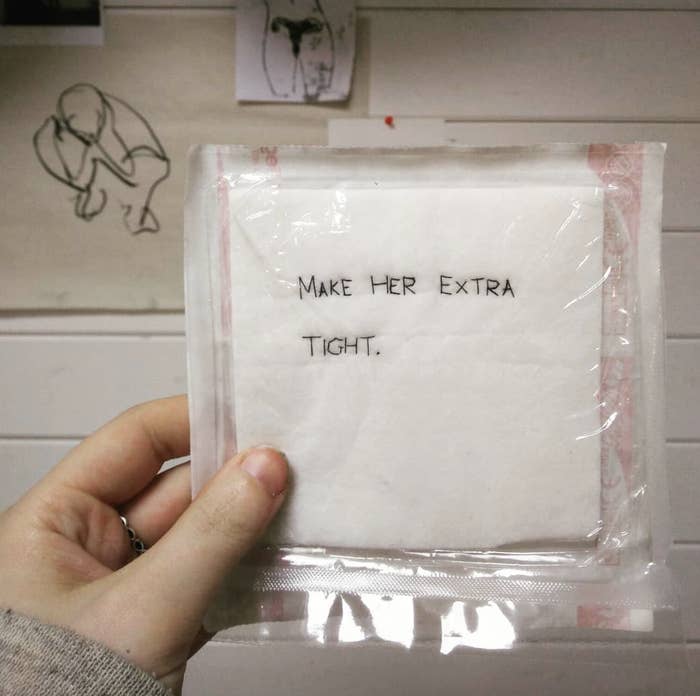After recently asking moms what sex was like after birth, we realized a lot of women said they were given a "daddy" or "husband stitch."

Because this type of procedure seems ~very~ controversial, BuzzFeed spoke to some experts about the topic: David Ghozland, MD and Mary Jane Minkin, MD.
Ghozland is a board-certified OB-GYN and cosmetic gynecologist and Minkin is a clinical professor of obstetrics, gynecology, and reproductive sciences at Yale School of Medicine.

Is the "husband stitch" a real thing?
Ghozland: The "daddy stitch" is the biggest fallacy out there. I say this because you can’t put in a daddy stitch without a defined area that’s going to be linear down the vagina in a midline in order to tighten the vagina. So, just on that basis, nobody gets an extra stitch just to make you tighter. Second of all, you would never do a vaginal tightening procedure during delivery because the patient has been in labor for so long. They’ve been pushing, they’re really swollen, and their tissue is swollen. Everything is really unorganized and discordant, so it’s definitely not any time to do any cosmetics or plastic reconstruction. Besides that, there’s a lot of blood involved during delivery and it’s very hard to see. You have to work pretty fast because you’re repairing the tears, delivering the placenta, etc.
You would need way more than one stitch in order to do an effective job in repairing pelvic floor muscles and making somebody tight, so I think the "father stitch" started as a fun, "Hey dad, do you want me to put an extra stitch" sort of joke, and over the years it has kind of taken on a life of its own. I do not know anyone who has performed a "daddy stitch."
But, don't get me wrong, if someone didn't do a proper job of fixing or repairing what tore, it could cause painful intercourse afterwards. But it's not that they intentionally made it too tight, I think it's more erroneous on the part of the repair itself as opposed to it being a "daddy stitch."
Minkin: It's an ancient concept, but I do not think the "daddy stitch" is a joke. The stitch was called the "crown stitch," and it was a legitimate stitch — it was the last stitch in at the top for support after an episiotomy. I delivered my first baby in 1973, so when I was in training, it was standard to do an episiotomy. The "crown stitch" was supposed to build up the perineum to give some posterior support. So, basically, what you were doing was tightening the vagina a little bit and the slang term for that stitch was the "husband stitch." The key question is how deep do you make the stitch, and how tight do you make the stitch?
Do doctors perform episiotomies today?
Ghozland: I would say that 95% of all physicians today do not cut episiotomies during the time of delivery. They allow the patient to tear superficially on their own. The tear may be anywhere along the outside or along the labia; you really don’t know where the person is going to tear. The reason we don’t cut episiotomies is because all studies in literature today have shown that making an incision with scissors causes the woman to tear naturally deeper than they have to and it really causes injury to the pelvic floor muscles.
Minkin: The trend and recommendation from the College of OB-GYN (and similar places) is to not do episiotomies. You let the baby take what it needs to come out, but don't put an extra cut in there. Then whatever is torn, you sew it back together.
Are "husband stitches" performed today?
Ghozland: I don’t think — whether it’s years ago or today — anybody goes into a delivery purposely thinking that they’re going to tighten somebody at the same time because tightening somebody is very different than repairing a tear or an episiotomy. When I do vaginal tightening procedures it's a very different approach. My incisions are very different because I'm really trying to correct the pelvic floor muscles.
Minkin: My partner still does a lot of deliveries and he says fathers will occasionally ask for the "daddy stitch." Whenever they do, my partner jokingly says, "How small do you need it?!"
How are gynecological practices different today?
Minkin: There's a lot of interesting changes in gynecological practice today. For instance, about 30-some years ago, when we used to do tubal ligations on women, we had to have the husband’s permission. Also, it is very interesting to note that in Brazil, most wealthy women do not have vaginal deliveries. They prefer a C-section, and a lot of this has to do with the women wanting their vaginas to remain the same. You can read more about this topic here.
What can women do to prevent tearing during vaginal delivery?
Ghozland: Three to four weeks before your due date, you can do a perineal massage every day to decrease your chances of tearing by 10% to 15%. There are a lot of changes and loosening that happen after delivery, which is normal. I try to promote pelvic floor rehabilitation using pelvic floor exercises like Kegels or other devices that will help to tone the muscles. Continuing to do exercises during pregnancy and after delivery that will keep those muscles in tone, or rejuvenate some of that tissue, is recommended.

